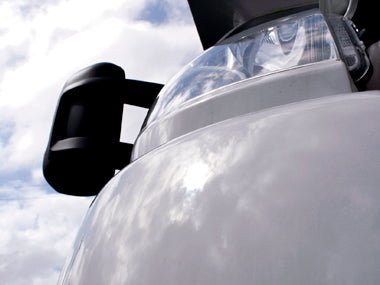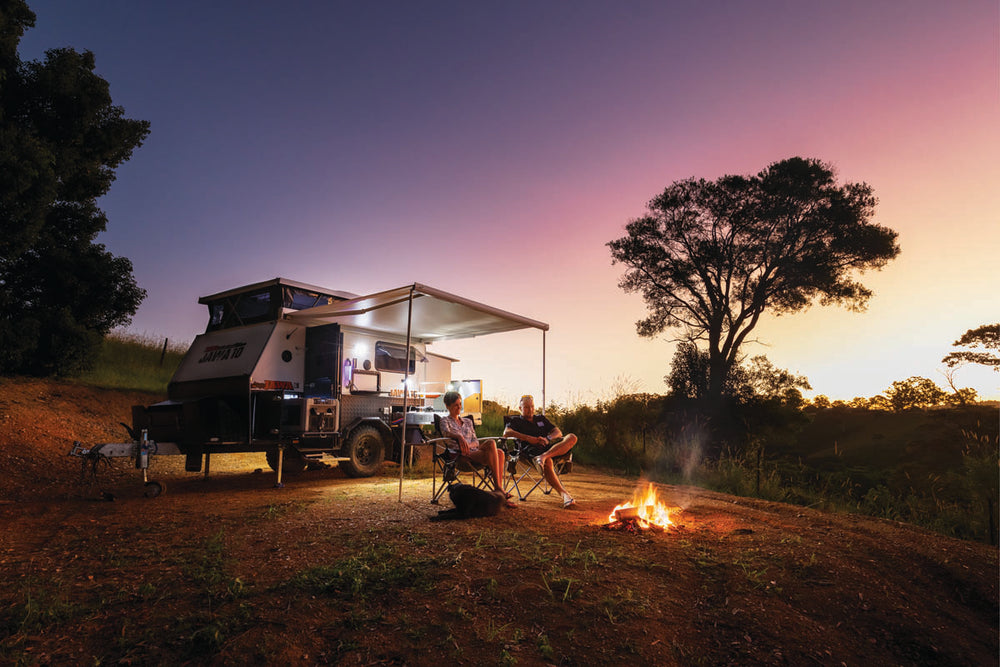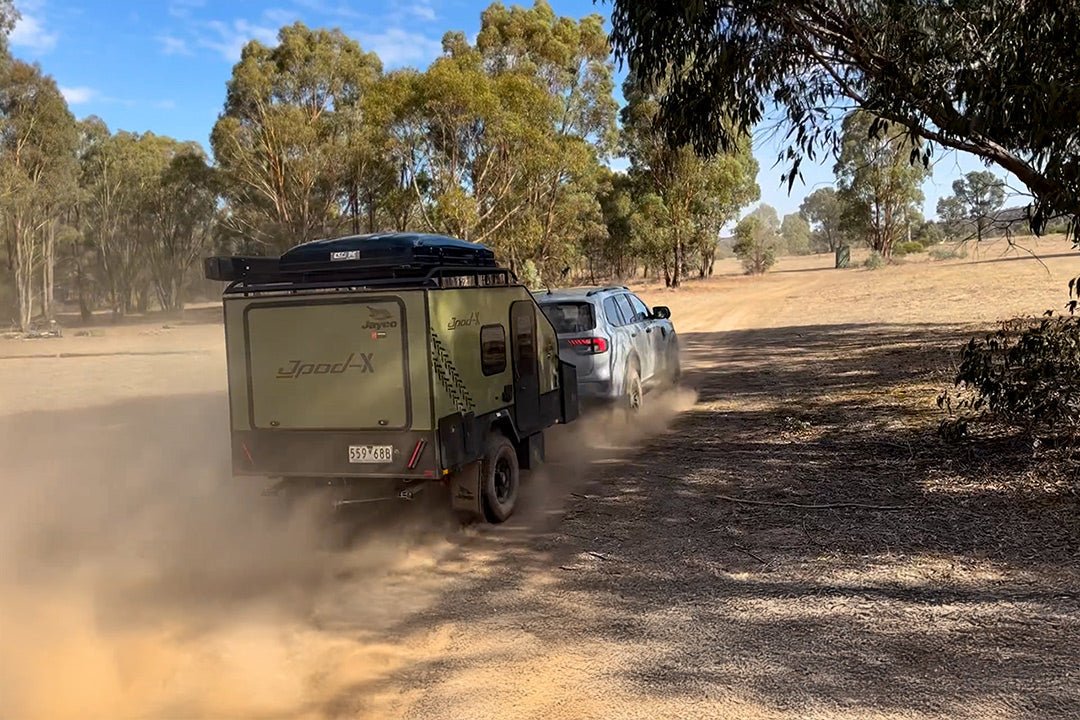DIY Detailing On Your Caravan/Motorhome

A caravan or motorhome has a lot of large surface areas that are a chore to keep spotless. But if you are prepared to invest some time and money in taking care of paint and trim, your pride and joy will look much better for longer and be much easier to clean into the bargain.
You’ll save money by polishing the rig yourself but it’s best not to scrimp on the quality of the equipment. A cheap generic brand polish will do the job but it won’t last as long, will be difficult to apply and polish off, and won’t give the shine of a quality product. If it’s a cutting compound, it’s likely to be too abrasive, so if you’re not careful, you’ll be left with a dull patch of paint – or worse still, no paint at all. Be prepared to spend $150-$250 on everything you need for paint and trim care.
There are three stages to paint care: cleaning paint surfaces in preparation for paint correction, paint correction (polishing) and paint protection.
THE BASICS
Automotive paint on your motorhome cab will most likely have a primer coat, colour coat(s) and a hard clear top coat(s), which is a relatively durable finish to work with.
The paint surfaces on a powder-coated colourbond aluminium van, however, are thin colour coats only, with no clear coat. This type of paint is easy to rub through and needs the most care when polishing.
Fibreglass composite finishes typically have a thick resin coat that polishes up well and has ample thickness.
An orbital buffer or a rotary buffer gives consistent results with least effort for polishing/waxing, but I would recommend hand-polishing only – especially on the thin powder-coated aluminium sheet finish of many vans, which damages easily and is difficult if not impossible to use a buffer on anyway with its rippled surfaces. If you are keen to try a buffer, visit one of the web links in the separate box on the following page for advice.
Round, foam hand-polishing pads, available at most auto parts shops or online detailing shops, are better than cloths as they are easy to handle and it’s harder to inadvertently apply too much pressure on the paint.
Polishing-off polish residue is much easier with a microfibre cloth than with an old T-shirt or other cotton cloth. Buy good-quality ones and you can throw them all into the washing machine on a gentle cycle to reuse them. About a dozen medium cloths are sufficient for a big job like a large van.
Before starting, park the rig under cover if possible, don’t work in direct sunlight in the middle of the day, and don’t work when it’s windy – all your good intentions might be undone by the dust and grit you inadvertently scratch onto your rig. Make sure you have enough light to see what you’re doing.
Be aware of your clothes: belt buckles, wedding bands, jeans studs and wrist watches are all potential scratch-makers. Wear clothes that won’t scratch, and remove jewellery.
Polymer polishes with no silicone content are better than the silicone-based ones. Most specialist detailing shops, many of which are online, will point you in the right direction. Some polishes that are marketed as scratch-remover actually have a filler in them: they don’t remove all of the scratch and partly fill it instead. You’ll notice that the scratch reappears after a while as the filler wears off.
If you can feel a scratch by sliding a finger nail across it, it’s too deep to remove totally, but a good-quality, fine cutting polish will remove most of it and make it less obvious. Be really careful with powder-coat scratch removal: you don’t have much paint thickness to play with.
CLEANING
Give your rig a thorough wash using a household detergent to remove any remaining wax and grime.
The next step is to remove stubborn contaminants on the paint with a clay bar, which is a pliable, synthetic material that feels a bit like Blu Tack. Nothing works as well as a clay bar to remove bugs, sap, bird droppings and particulate pollution. It’s one of car detailing’s best inventions, and is used as follows:
Once your paint surface is washed clean and dry, pull off a one-fifth segment of clay bar and flatten it. ‘Clay’ needs something to glide over the paint surface, so use a lubricant such as soapy water or a ‘quick detailer’ spray. After you’ve sprayed a section of paint, rub the clay over the surface in a forwards and backwards motion with light to medium pressure until you feel the paint is smooth, and wipe off the excess lubricant with a microfibre cloth. You can fold or knead the same piece of clay to get a ‘fresh’ section to rub on the paint several times before you need to discard it.
After the clay bar treatment, it’s time for a quick rinse and dry in preparation for polishing.
POLISHING
For powder-coated vans that have weathered a little, use a mildly abrasive one-step polish/sealer on the paint to remove the oxidised top layer while not removing too much good paint underneath. For brand-new vans, a non-abrasive sealer might be enough, but even new vans can have minor imperfections that a mild abrasive polish will take off.
You may notice holograms or swirl marks and scratches in the clear-coated paint areas in particular, such as on a motorhome cabin. Use a couple of stages of a multi-stage light cutting compound (some are sold in four cutting grades from heavy to very light) to remove such imperfections and make your motorhome paint reflect like a mirror – after a lot of elbow grease.
Once you’ve used a light-abrasive polish, you can maintain the paint with a wash, clay bar and then just a sealer or wax top coat every three to six months.
Pay attention to polish manufacturer instructions, which can make a world of difference to how easy the polish is to apply and how long it lasts. When instructions say to apply thin coats, do so, otherwise it will smear and prove difficult to work with.
Wipe off the polish residue with a microfibre cloth. How long till you remove the residue? Again, it will depend on the instructions: some are best removed almost immediately after application, with others you need to wait until they have dried to a haze.
Some polish manufacturers also suggest a temperature range in which to apply the polish. If you are working outside this range, you might find it is harder work than necessary. Humid conditions also make it harder to remove the polish residue, with the polish ‘clogging up’ in the cloth. You may just need to use more cloths to get the job done, or wait for drier weather.
Make sure to regularly change to a fresh polishing cloth too. Don’t persist with a cloth that has filled with polish as it just makes your job harder.
WAXING
Waxing a caravan is a satisfying, last step to polishing your rig. Good carnauba wax is expensive but will give paint a deeper lustre than a sealer only, and while it takes extra effort, it will be relatively quick to apply because your paint is already cleaned and polished.
Some reasonable waxes cost as little as $20, but a good-quality wax is typically around the $80 mark for a tub that should stretch to two coats on an average-sized rig. Even a quality wax won’t afford the same protection as a good polish/sealer, only lasting a month or two in the open, but if you cover your rig it will last longer.
OTHER DETAILS
There are many ins and outs for detailing, and we haven’t covered issues such as plastic and rubber protection (you can by UV-resistant products for this) and removing scratches from Perspex windows (again, there are products available). Plenty of interior care products will protect and rejuvenate leather and vinyl, and also protect fabric against staining and UV damage.
Maintaining you rig’s paintwork requires a fair bit of effort the first time, but once you have started, it does get easier to keep up. It will all be worth it when the buyer or trade-in valuer lays eyes on your gleaming rig.
Detailing requires a lot of elbow grease but the results will be worth it; Use a quality microfibre cloth for best results; Clay bar in the packet; Using a clay bar to remove contaminants; Careful use of a fine, multi-stage cutting compound can make your motorhome paint reflect like a mirror.







